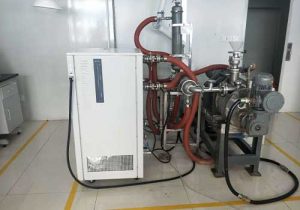water cooled chiller cycle
Understanding the Water-Cooled Chiller Cycle
Water-cooled chiller cycles are essential in a variety of applications, from industrial processes to HVAC systems. These chillers operate on the principle of the vapor compression cycle, which involves transferring heat from a lower temperature reservoir (the fluid being cooled) to a higher temperature reservoir (the external environment). Here’s how the water-cooled chiller cycle works:

The Refrigeration Cycle:
The heart of a water chiller is its refrigeration cycle, which relies on the principles of thermodynamics. The cycle typically consists of four main components: the evaporator, compressor, condenser, and expansion valve. These components work together to transfer heat from the water or fluid being cooled to the external environment.
Components of the Water Chiller Cycle:
Evaporator: The evaporator is where the heat exchange occurs between the refrigerant and the water or fluid being cooled. It consists of a coil or tubes through which the refrigerant flows, absorbing the heat from the fluid and evaporating in the process.
Compressor: The compressor is responsible for circulating the refrigerant and increasing its pressure and temperature. It plays a vital role in the refrigeration cycle by compressing the low-pressure gas from the evaporator into a high-pressure gas for further heat removal.

Condenser: The condenser is where the refrigerant releases heat to the external environment and condenses back into a liquid state. It consists of coils or tubes that allow efficient heat transfer between the refrigerant and the cooling medium, whether it is air or water.
Expansion Valve: The expansion valve regulates the flow and pressure of the refrigerant. It reduces the pressure of the high-pressure liquid refrigerant coming from the condenser, allowing it to expand and evaporate in the evaporator. This process completes the refrigeration cycle and enables continuous cooling.
Heat Absorption and Dissipation:
Water chillers work by absorbing heat from the water or fluid being cooled. As the refrigerant evaporates in the evaporator, it absorbs heat from the fluid, lowering its temperature. This heat absorption process continues until the fluid reaches the desired temperature. Once the refrigerant absorbs heat from the fluid, it undergoes compression in the compressor, which increases its temperature and pressure. The hot, high-pressure gas is then passed through the condenser, where heat is released to the surrounding environment. This heat dissipation process allows the refrigerant to condense back into a liquid state.
Continuous Cycle:
The refrigeration cycle in water chillers is continuous, meaning it repeats itself as long as the chiller is operating. The expansion valve controls the flow of refrigerant, maintaining the cycle’s efficiency and ensuring a consistent cooling process.

Types of Water Chillers:
Water chillers come in various types, each suited for specific applications and cooling requirements. The most common types include air-cooled chillers and water-cooled chillers. Water-cooled chillers use water from an external cooling tower to reject heat from a gaseous refrigerant in the condenser before it undergoes a phase change into a liquid.
Market Trends and Environmental Impact:
The global water-cooled chillers market is growing, with a focus on energy efficiency and environmental sustainability. The market is influenced by factors such as the need for more efficient cooling systems, advancements in refrigeration technology, and increasing environmental regulations. The carbon footprint of chiller systems is also a concern, with efforts being made to reduce energy consumption and adopt more eco-friendly refrigerants .
Conclusion
The water-cooled chiller cycle is a vital process that enables precise temperature control in numerous industries. Understanding the components and principles of this cycle is essential for selecting the appropriate chiller system and ensuring its efficient operation. As technology advances, the focus on energy efficiency and environmental impact will continue to shape the development and application of water-cooled chiller systems.
Related recommendations
chiller function
528Understanding Chiller Function: The Core of Industrial Cooling Systems Chillers are vital components in many industrial and commercial cooling systems, providing precise temperature control for...
View detailsindustrial chiller cost
797Understanding Industrial Chiller Cost Industrial chillers are essential for maintaining optimal temperatures in various commercial and industrial processes. The cost of these chillers is a sign...
View detailsClosed Refrigeration and Heating Cycle Device
1352Closed Refrigeration and Heating Cycle Device The closed refrigeration heating cycle device is used in industries with strict temperature requirements, which can combine heating and cooling ...
View detailsFactors Affecting the Cooling Effect of Industrial Chiller Condenser
1079Factors Affecting the Cooling Effect of Industrial Chiller Condenser Environment As long as the condenser of the industrial chiller is within the normal operating range, the overall worki...
View details
 LNEYA Chiller
LNEYA Chiller






HelloPlease log in